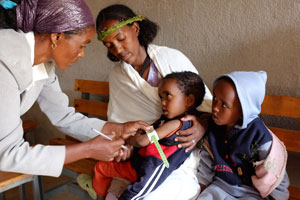Australia is investing in a health program in Ethiopia that will result in more trained health workers and which aims to reduce maternal and infant deaths.
Foreign Minister Kevin Rudd announced the new $43 million four-year contribution while in Ethiopia for the Africa Union Summit on 26 January 2012.
Working with the Ethiopian Ministry of Health, which has a proven track record for delivering results, Australia's investment will save lives.
The Ethiopian Government has shown a real commitment and good progress in improving the health of its people. Australia will work with Ethiopia to halve the number of women who die giving birth and halve the number of children who die before they reach their first birthday.
Over the next four years the program aims to increase the number of trained midwives from 2002 to 8635, helping to increase the number of births attended by a midwife from 18 to 62 per cent.
This will also help to reduce maternal deaths from 590 to 267 deaths per 100,000 births, and reduce infant deaths from 59 to 31 per 1000 live births.
The program will also help measles immunisation reach 90 per cent of the population.
While in Addis Ababa Mr Rudd met with the Ethiopian Minister for Health, Dr Tedros Adhanom, signing a bilateral agreement for the new health investment.
'This work will build on Ethiopia's impressive health gains made since 2005, and help keep the country on track to meet their millennium development goal targets for child health,' Mr Rudd said.
Preliminary findings from the Ethiopia Demographic and Health Survey show that infant mortality has already decreased by 23 per cent from 77 to 59 deaths per 1000 births. Under-five mortality rates have decreased by 28 per cent from 123 to 88 per 1000 births, and the use of contraceptives has nearly doubled from 15 to 29 per cent.
These findings are promising, but Ethiopia still has a long way to go. In Australia one in 7400 births results in the death of the mother. By comparison, in Ethiopia, this number is one in 170.
More information on Australia's assistance to Sub-Saharan Africa


